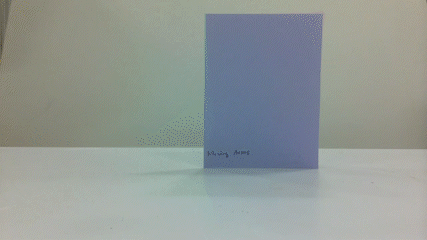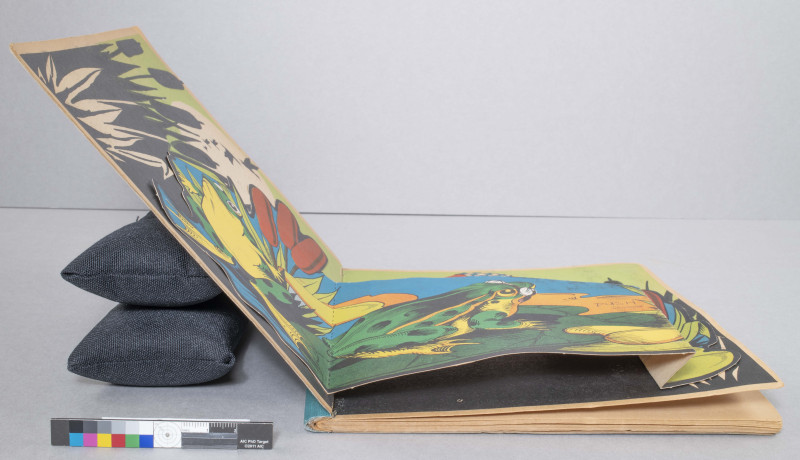Guest post by Shaoyi Qian, summer 2021 Cathleen A. Baker Fellow in the U-M Library conservation lab and current Andrew W. Mellon Fellow in Library & Archive Conservation, Institute of Fine Arts, New York University. These posts feature Shaoyi's treatments for books from The William A. Gosling Pop-up and Movable Book Collection, part of the Children's Literature Collection in the Special Collections Research Center.
The term ‘pop-up book’ was not coined until the 1930s, but pop-up books were quickly embraced by publishers, paper engineers, book artists and the general public. In this last post of the series, I will talk about a challenging treatment of a 1930s’ pop-up book, Blinky Bill.
This book contains three pop-ups. The first pop-up (pop-up #1) is built upon a parallelogram and uses a “moving arms” mechanism.

Moving arms mechanism of pop-up #1
The second pop-up (pop-up #2) uses a parallel-fold structure with decorative parts cut away.


Pop-up #2 after treatment (above) and the parallel-fold structure (below)
The third pop-up (pop-up #3) also uses the parallelogram structure.


Pop-up #3 after treatment (above) and the parallelogram structure (below)

Blinky Bill before treatment (click here to view the video)
The before treatment video shows that the leaping koala in pop-up #1 was not fully popping, leaving his face hidden. This was caused by a crudely executed repair of the cover boards that restricted the book from opening fully.

Pop-up #2, before treatment. The opening is quite restricted.
The old repair restricted the movement of the spine, which caused the pages to pivot along the edge of the repair cloth, instead of the spine.


The cover and the pages flex improperly because of the old repair.
The old repair also caused the back cover to split along the edge of the repair cloth.

The back cover had split due to the previous repair.
The key to restoring the moving elements was to remove the badly repaired spine and to reconstruct the binding. A new spine piece needed to be created for the latter. Conservators sometimes make mock-ups before the actual treatment to test out the result. Factors such as size, thickness, and rigidity of the original materials are replicated in the mock-up, since they all contribute to the function of the book. To make sure that our design of the new spine piece would work, we made a mock-up of the book where the exact shapes and positions of the pop-ups were replicated.
For the new spine piece, a high-quality binders board (Eterno board), chosen for its strength and flexibility, was pared down to an appropriate thinness. It was lined with Japanese paper toned to a color similar to the textblock paper. The new spine piece was sewn on with the textblock and tucked underneath the original decorative facing paper of the boards.


Design of the re-construction of the binding (above); Mock-up of the re-construction (below)
The success of the mock-up made us confident to proceed. The book, which was a single signature bound with staples, was first taken apart. This made it easier to access and repair the covers and the movable elements. Some areas of pop-up #1 had also been improperly repaired, so these old repairs were removed with a heated spatula.
Before repairing the binding, great effort was taken to salvage as much original material below the repair cloth as possible. This was a difficult task because the repair cloth consisted of a thick bookcloth adhered with a lot of water in-soluble adhesive, and the original material below was very fragile. Again, organic solvents and heat were required to remove the repair cloth.
There were old repairs underneath the right glueing tab of pop-up #1. Therefore, the right glueing tab was detached and heat was used to remove those old repairs.

Verso of pop-up #1 with the old repairs removed

Re-sewing the textblock with the new spine piece. It was challenging to reach under this pop-up.
With the binding structure rebuilt and functioning properly, it was time to reattach the right glueing tab of pop-up #1. When making a pop-up, after one glueing tab is adhered, you should let the other find its own spot by folding the pop-up piece into its closed position and then closing the book. This is much more accurate than any mathematical calculations of distance or angles, and this is how the pop-up was reattached in this treatment.

The moment of truth: opening the book for the first time after reattaching pop-up #1 to see if Blinky Bill would finally pop out.
The last steps of this treatment were cosmetic. The new spine piece was covered with toned Japanese paper (see A below). The decorative paper salvaged from removing the repair cloth was put back (see B below). Finally, I retouched some losses with watercolor (see C below).

Different stages of the cosmetic treatment of the covers (from left to right: A, B and C)
Pop-ups #2 and #3 only required some minor repairs. After those were done, Blinky Bill was again fully functional!

Blinky Bill after treatment (click here to view the video)
Tackling three books with different movable structures and damage, and making them functional and safe to handle was a fun and rewarding experience for me. I am excited that future users can now actually interact with these books again. There is still a lot yet to be explored in the world of pop-up and movable books in the William A. Gosling Pop-up and Movable Book Collection at U-M Library!